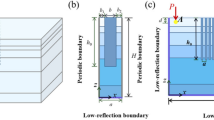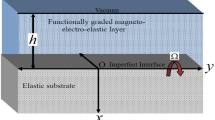Abstract
In this study, a triangular array of cylindrical holes was shown to function as a local resonator to seismic metamaterials against the vibration generator loading in the geophysics concept. The field test showed that the seismic waves applied to one side of the proposed array interacted with the triangularly arranged holes, resulting in a strong attenuation in two narrow frequency bands. The numerical analysis was carried out using simulations based on the finite element method, which provides optimal dimensions and arrangement at a sub-wavelength scale to achieve maximum attenuation against incoming seismic wave at a very low frequency range. Different band gaps were observed due to interaction of the longitudinal resonance between the cylindrical holes and vertical components of soil response under the applied wave. Experimental analysis was carried out using optimum dimensions and hole arrangements, and a strong attenuation due to impedance matching between soil and seismic metamaterials was shown. It was also observed that, at very low frequencies, the soil response was due to the inverse proportionality between the resonator length and the seismic energy wavelength applied for longitudinal resonance. Two band gaps have been observed around 25–36 Hz as shown in band diagram. The proposed structure exactly prevents the seismic wave propagation at 25 Hz and 36 Hz in accordance with band diagram. Therefore, the proposed system can prevent the seismic waves from attaining the backside of the seismic array. The attenuation was obtained at a level of 0.00125, observed at a 0.0001 source point, measured by a speed sensor located at the back of the seismic metamaterials, with an attenuation rate of 12.5 at 8 Hz.










Similar content being viewed by others
References
Achaoui Y, Ungureanu B, Enoch S, Brule S, Guenneau S (2016) Seismic waves damping with arrays of inertial resonators. Extreme Mech Lett 8:30–37
Achaoui Y, Antonakakis T, Brule S, Craster RV, Enoch S, Guenneau S (2017) Clamped seismic metamaterials: ultra-low frequency stop bands. New J Phys 19(6):063022
Brule S, Javelaud E, Enoch S, Guenneau S (2013) Seismic metamaterial: how to shake friends and influence waves. arXiv preprint arXiv:1301.7642
Brule S, Javelaud EH, Enoch S, Guenneau S (2014) Experiments on seismic metamaterials: molding surface waves. Phys Rev Lett 112:133901
Brule S, Enoch S, Guenneau S (2017) Emergence of seismic metamaterials: current state and future perspectives. arXiv preprint arXiv:1712.09115
Casablanca O, Ventura G, Garescì F, Azzerboni B, Chiaia B, Chiappini M, Finocchio G (2018) Seismic isolation of buildings using composite foundations based on metamaterials. J Appl Phys 123(17):174903
Dertimanis VK, Antoniadis IA, Chatzi EN (2016) Feasibility analysis on the attenuation of strong ground motions using finite periodic lattices of mass-in-mass barriers. J Eng Mech 142(9):04016060
Du Q, Zeng Y, Huang G, Yang H (2017) Elastic metamaterial-based seismic shield for both Lamb and surface waves. AIP Adv 7:075015
Dutta G, Mukerji T, Eidsvik J (2019) Value of information analysis for subsurface energy resources applications. Appl Energy 252:113436
Fırıncıoglu BS, Ercanoglu M (2019) Two-and three-dimensional slope stability evaluation in a residential area: Denizkonak landslides in Cide (Kastamonu, NW Turkey). Nat Hazards 99(1):449–466
Krödel S, Thomé N, Daraio C (2015) Wide band-gap seismic metastructures. Extreme Mech Lett 4:111–117
La Salandra V, Wenzel M, Bursi OS, Carta G, Movchan AB (2017) Conception of a 3D metamaterial-based foundation for static and seismic protection of fuel storage tanks. Front Mater 4:30
Lim CW, Reddy JN (2019) Built-up structural steel sections as seismic metamaterials for surface wave attenuation with low frequency wide bandgap in layered soil medium. Eng Struct 188:440–451
Mert BA, Dag A (2017) A computer program for practical semivariogram modeling and ordinary Kriging: a case study of porosity distribution in an oil field. Open Geosci 9:663–674
Mignan A, Karvounis D, Broccardo M, Wiemer S, Giardini D (2019) Including seismic risk mitigation measures into the Levelized Cost Of Electricity in enhanced geothermal systems for optimal siting. Appl Energy 238:831–850
Miniaci M, Krushynska A, Bosia F, Pugno NM (2016) Large scale mechanical metamaterials as seismic shields. New J Phys 18:083041
Palermo A, Krödel S, Marzani A, Daraio C (2016a) Engineered meta-barrier as shield from seismic surface waves. Sci Rep 6:39356
Palermo A, Krödel S, Marzani A, Daraio C (2016b) Engineered metabarrier as shield from seismic surface waves. Sci Rep 6:39356
Qiu J, Wang X, Lai J, Zhang Q, Wang J (2018) Response characteristics and preventions for seismic subsidence of loess in Northwest China. Nat Hazards 92(3):1909–1935
Roux P, Bindi D, Boxberger T, Colombi A, Cotton F, Douste-Bacque I et al (2018) Toward seismic metamaterials: the METAFORET project. Seismol Res Lett 89(2A):582–593
Wagner PR, Dertimanis VK, Antoniadis IA, Chatzi EN (2016a) On the feasibility of structural metamaterials for seismic-induced vibration mitigation. Int J Earthq Impact Eng 1(1–2):20–56
Wagner PR, Dertimanis VK, Chatzi EN, Antoniadis IA (2016) Design of metamaterials for seismic isolation. In: Dynamics of civil structures, vol 2. Springer, Cham, pp 275–287
Wang X, Zeng X, Yang X, Li J (2019a) Seismic response of offshore wind turbine with hybrid monopile foundation based on centrifuge modelling. Appl Energy 235:1335–1350
Waseem M, Khan MA, Khan S (2019) Seismic sources for southern Pakistan and seismic hazard assessment of Karachi. Nat Hazards 99:511–536
Witarto W, Wang SJ, Yang CY, Nie X, Mo YL, Chang KC et al (2018) Seismic isolation of small modular reactors using metamaterials. AIP Adv 8(4):045307
Zeng Y, Peng P, Du QJ, Wang YS (2019) A novel zero-frequency seismic metamaterial. arXiv preprint arXiv:1907.06446
Acknowledgements
We would like to thank the Disaster and Emergency Management Presidency of Turkey (UDAP-Ç-19-21) for the financial support.
Author information
Authors and Affiliations
Corresponding author
Additional information
Publisher's Note
Springer Nature remains neutral with regard to jurisdictional claims in published maps and institutional affiliations.
Rights and permissions
About this article
Cite this article
Kacin, S., Ozturk, M., Sevim, U.K. et al. Seismic metamaterials for low-frequency mechanical wave attenuation. Nat Hazards 107, 213–229 (2021). https://doi.org/10.1007/s11069-021-04580-5
Received:
Accepted:
Published:
Issue Date:
DOI: https://doi.org/10.1007/s11069-021-04580-5




